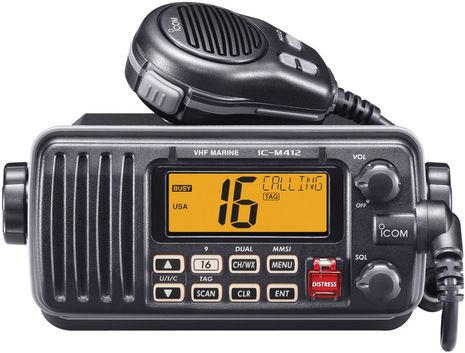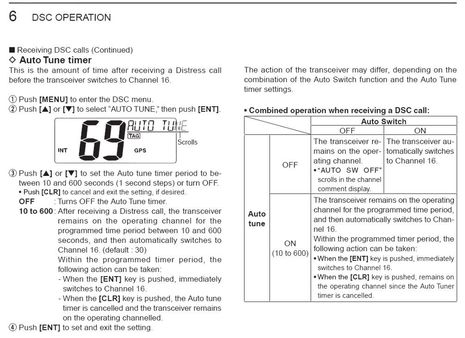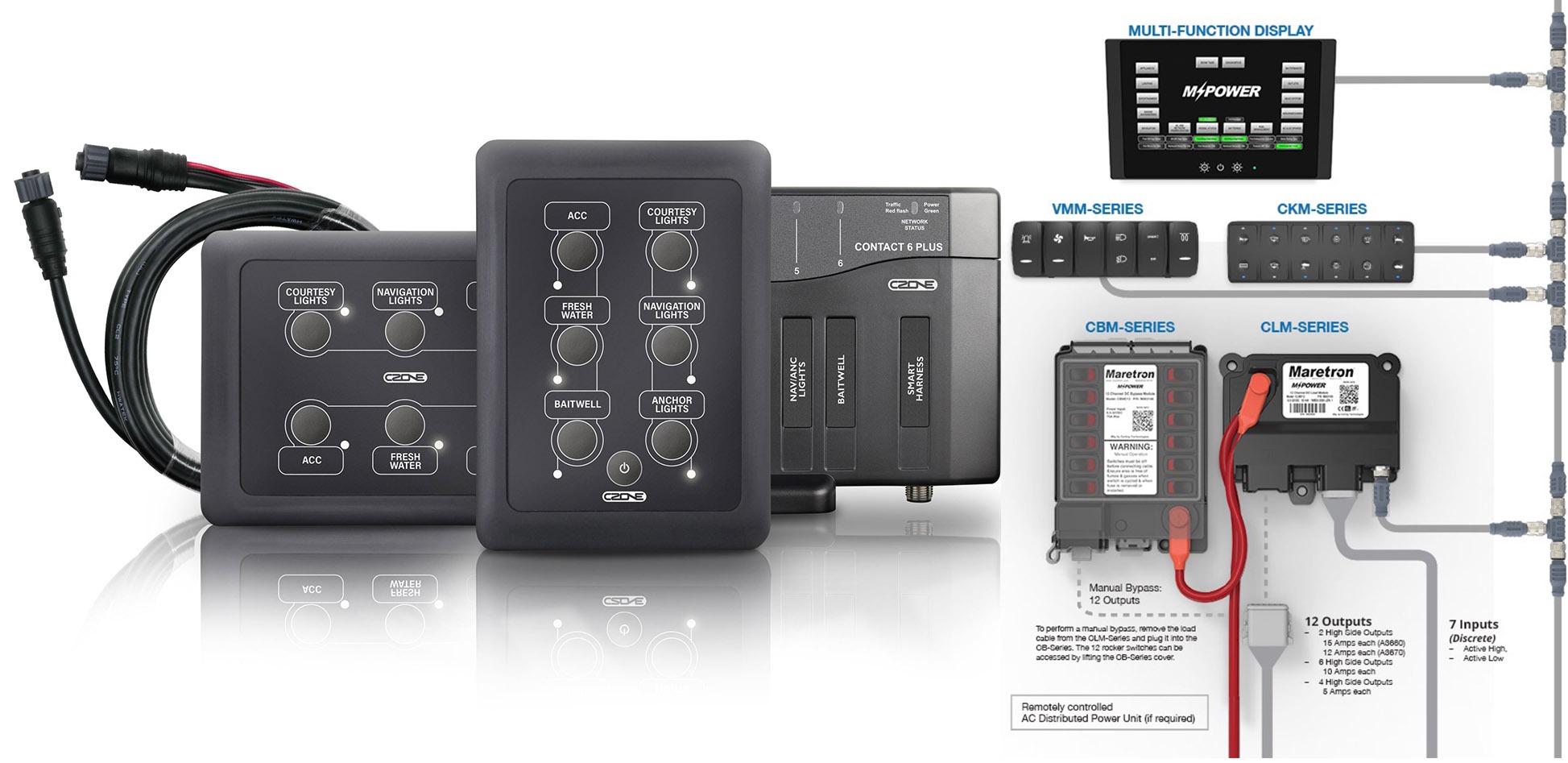Icom M412, best DSC channel switching control?
The Icom pitch for its new IC-M412 is straight forward — “Compact, Easy to Use and a Great Value” — and probably quite true. You could argue that Standard Horizon’s new GX1600 is even more compact, and its GX1150 even a greater value, but the bigger picture is that the two big VHF manufacturers now have small Class D DSC radios at pretty reasonable prices (though — darn it — neither has yet adopted NMEA 2000 interfacing). But there are at least two subtleties to the Icom M412 worth noting…
For one thing, the M412 will purportedly play nicely with Icom’s MA-500TR Class B AIS transponder, which means it will be easy to integrate them (using NMEA 0183) and to make a direct DSC VHF call to a selected AIS target. (Incidentally, I don’t know why the MA-500TR, which was announced a year ago, is still waiting FCC approvals, but I’ll guess that it will be available soon.)
You have to dig into the M412 manual (downloadable on that product page) to understand how it deals with the issue of your radio automatically switching to channel 16 upon receipt of a DSC distress call. Issue? Well, please recall our discussion when the USCG put out an alert on this matter last May. Note also the strong desire to turn off auto switching expressed by commenters to that recent Standard Horizon entry. As I commented myself there, I like Standard’s approach — which doesn’t let you turn off auto switching altogether, but does give you 10 seconds to either pause or quit an auto switch if you’re doing something critical with your radio. But it looks Icom expands on this idea, letting you set the switch/no switch decision period all the way from 10 to 600 seconds if you want. You can also turn off auto switching on the M412 altogether, but I’m hoping most operators won’t given that they can set a long period during which they can accept or cancel a channel switch. After all, in most circumstances wouldn’t you want to hear what someone in distress has to say on 16?
















Well, nice radio, but not much improved over my six year old Uniden UM625C with wireless remote. If Icom had added NMEA 2000 I could justify an immediate upgrade. Right now I believe Garmin’s VHF 200 still has the feature set worth making a change and as Spring approaches this is what I will buy.
I was impressed by the video showing the Icom M23 handheld.
I wonder why the VHF makers are so slow to adapt to NMEA2000? I believe only Garmin has made one.
My Simrad system is completely NMEA2000(well.Simnet).
It seems a shame to me to introduce a 183 device into my system (hardwiring to a pigtail on the NSE),when with the Simnet I could just plug and play.
Lowrance also has a NMEA 2000 VHF radio, and I think theirs was the first lower costs option out there. At the time, only their Simrad brother had Simnet.
Chris
I don’t get it either, Peter. I’ll guess that the VHF manufacturers figure that not many boaters will pay extra for NMEA 2000, but I think that’s changing fast. Plus Lowrance managed to build an economical N2K radio (though not Class D) a few years ago:
https://panbo.com/archives/2007/08/lowrance_n2k_fmvhf_and_more.html
Note also that Simrad built the first N2K/Simnet radios, I’m pretty sure (though they are expensive):
http://www.simrad-yachting.com/Products/Communication-AIS/VHF-Radio-Systems/
All of which makes it disappointing that Simrad’s “New” VHFs are just 0183:
https://panbo.com/archives/2011/01/garmins_wireless_vhf_mic_simrads_too.html
The European version of the Lowrance VHF with N2K, LVR-880E has always been Class D.
You can now get low cost microcontrollers with built-in CAN interface so it should not be the cost prohibiting VHF’s with NMEA 2000. Since the the leaders in NMEA 2000, Simrad, Lowrance and Garmin all have VHF radios with N2K interface, but the two leading VHF suppliers don’t, I guess the problem is lack of NMEA 2000 competence in Icom and Standard Horizon.
Just thinking … if it was me designing the NMEA-2000 interface for a VHF radio I would be asking …
1. What PGN would I use to accept a request over N2K to make a DSC VHF call to a selected AIS target ?
2. Would I support any of the proprietary PGN’s in use today, in addition to a standard PGN ?
3. Do I need a method to allow my VHF’s software to be upgradable over NMEA-2000 so that in the future i) my radio could support other features that would do away with users needing to use my front panel DSC user interface ?
ii) my radio can support other proprietary PGN’s ?
4. If I need to be upgradable, what would I offer users as client software to upload a new version over NMEA-2000 ?
5. Can I get FCC approval for my radio if its field upgradable by end users ?
6. Will I have an increase in sales if I add NMEA-2000, or would we find out instead that someone who really wanted NMEA-2000, would still choose to purchase a N2K compatible radio from a manufacturer that also sells chartplotters?
Perhaps the answers to these questions, or lack of answers, have something to do with slow adoption of NMEA-2000 on vhf radios?
Dan, here are my thoughts on your questions:
1. What PGN would I use to accept a request over N2K to make a DSC VHF call to a selected AIS target ?
AFAIK no official NK2 PGN to instruct a VHF radio to set up a call is defined. I suspect two NMEA0183 sentences “DSI DSC Transponder Initiate” and “DSR DSC Transponder Response” exist for this purpose. To know for sure would mean to buy the standard. I would then know but could never speak about it again.
A PGN is defined for a VHF radio to send out the position of an incoming DSC call. It’s 129808, titled “12808 – DSC Call Information” on the NMEA web page. Note the missing “9”. It was defined only recently, though, and to my knowledge, the only radios to support it are the Garmin range.
2. Would I support any of the proprietary PGN’s in use today, in addition to a standard PGN ?
For lack of a standard PGN, you’d have to. But would you just output all of the Simrad, Garmin and possibly Raymarine simultaneously? Or make this user-configurable? I don’t envy you for that decision.
3. Do I need a method to allow my VHF’s software to be upgradable over NMEA-2000 so that in the future i) my radio could support other features that would do away with users needing to use my front panel DSC user interface ?
ii) my radio can support other proprietary PGN’s ?
You do as a standard may come around any time and eventually will be defined. Newly developed devices or those for which upgraded software is available may then support that standard.
4. If I need to be upgradable, what would I offer users as client software to upload a new version over NMEA-2000 ?
Ability to upgrade includes a host of problems to solve. If you’re only just beginning with N2K then that’s a big upfront investment.
5. Can I get FCC approval for my radio if its field upgradable by end users ?
I’ve asked myself that, too. Don’t have an answer and I’d very much like to know.
6. Will I have an increase in sales if I add NMEA-2000, or would we find out instead that someone who really wanted NMEA-2000, would still choose to purchase a N2K compatible radio from a manufacturer that also sells chartplotters?
Well I’d buy your radio but only if I don’t have to pay for all your development costs with just the one set I’m buying. Anybody else, I’m not so sure.
I certainly don’t want to stab N2K in the back but let’s remember that NMEA0183 has sentences for the required communications (DSC and DSE to output positions of calls and DSI and DSR to set up calls). So one way out is for Actisense to implement the following translation in the NGW-1:
1. DSC + DSE to PGN 129808 and reverse
2. DSC + DSE to each one of the proprietary PGNs for caller position of Simrad, Garmin and Raymarine (it’s 130816 in the case of Simrad as Kees has found out) and reverse
3. DSI and DSR to the matching proprietary PGNs of Simrad, Garmin and Raymarine for call set-up and reverse
4. DSI and DSR to the standard PGNs if and when they are defined and reverse
No 1. is not in place yet as Adam has reported. I don’t think 2. to 4. are there yet, either, but this could change quickly as Actisense issues frequent software updates and a process for user upgrade is in place. An intermediate device also solves the possible issue of the radio’s FCC license.
Damn! I wish NMEA hadn’t been so slow defining these PGNs. As best as I can tell, NMEA0183 sentences DSE, DSI and DSR were defined in 2005. I would think these sentences were defined because a legitimate need for them was deemed to exist. So why should this need not exist for N2K and why didn’t they just spend another 2 hours on the subject in 2005 to define the corresponding N2K PGNs?
Unless Actisense steps forward with the magic sword, I’m stuck with a Simrad dual station RS82 that I may need to replace because I can’t integrate it with Coastal Explorer or other PC software like Expedition for caller position display. (Off-topic: another reason why I may need to replace it is that it doesn’t support DSC position request and response. Neither does the RS87. So, as far as I can tell, poor superyacht owners can’t track their buddies or their tenders or their MOBs.)
If I replaced it, as I need a black-box dual-station type, pretty much the only choice is a Garmin VHF 300, maybe even with the new wireless mic recently featured here. But Coastal Explorer and Expedition only support NMEA 0183 DSC and DSE for position display at this time. As the Garmin VHF 300 can only be set to all NMEA0183 or all N2K, I would be forced back to NMEA0183 even on one of the few VHF radios supporting N2K.
And I am not even talking about call set-up (which CE doesn’t support at all). You would normally want to use call set-up on an AIS target and Garmin supports this but only via a chart plotter. There is no UI on the VHF radio allowing you to pick an AIS target to call even when using a Garmin AIS receiver/transponder or the VHF300 AIS model with an integrated AIS receiver.
To wrap up:
– interest in integration of VHF radios is increasing
– cross-manufacturer-integration is slim
– if you insist on N2K for cross-manufacturer-integration, you’re out of the game
– this is likely because standards aren’t defined or defined too late
– support for call set-up is only provided by closed-shop solutions including a chart plotter or by the Icom M412 or Standard Horizon GX2000/GX2100
– Dan, if you’re still thinking about putting N2K into your Icom or Standard Horizon radio, you should have that looked at
– only Actisense could save us
Please tell me where I am wrong because this is really depressing.
– I have to get rid of my Simrad dual station RS82, 4 years old, leaving lots of holes in my cockpit
– I can choose a Garmin VHF 300 which wouldn’t let me call an AIS target without a Garmin plotter
– or I can choose the Icom M412 or a SH GX2000 which would let me call an AIS target but they’re not a black box design and in my case would really mess up the navigation station
– I can completely forget about N2K, meaning a whole set of NMEA0183 wiring including GPS and AIS and the computer running CE
A different note: The Garmin VHF 300, possibly the other models as well, has a setting “DSC > AUTO CHANGE CH.” Selectable states are “ON—when a qualifying call is received, the radio automatically turns the channel to Channel 16.
OFF—when a qualifying call is received, a message is displayed that prompts you to accept or decline the changing of channels.”
Apparently, in OFF it waits forever and never changes the channel without user action.
Thanks, Dan and Henning! But let’s not forget that the first thing an N2K VHF can do is get GPS info off the backbone, plug ‘n play, bada bing, done. I also think they can easily put DSC call info onto the backbone using PGN 129808 (aka 12808), though I haven’t tested that feature very thoroughly. Finally, the PGN below — which may have come along with the last batch of AIS PGNs — may provide a standard way to set up calls from an MFD, like Garmin does.
At any rate, I am close to having the lab set up to do some extensive DSC testing. (Henning has been a motivator!).
129799 – Radio Frequency/Mode/Power
Category: AIS
This PGN provides status and control for a Radiotelephone, connected to a NMEA 2000 network. The Radiotelephone will transmit and receive status along with remote control and repeater products
Ben,
I understand in May, all radios will be required to have to recievers to meet the DSC channel. I am looking at the Icom 504 but am wondering if I should wait until June to see if there is a Icom model to replace the 504?
After the sunset date for RTCM SC-101 radios of March 25, 2011, I suspect that LOWRANCE will have to modify their LVR-880 radio being sold in the United States to make it DSC CLASS-D compliant.
When they do this, the LVR-880 will become the best choice for a NMEA-2000 compliant VHF Marine Band radio with Class-D DSC.